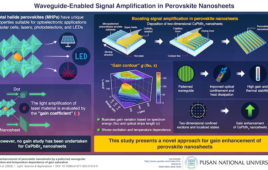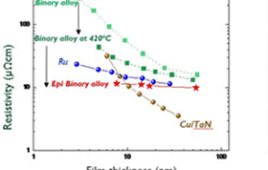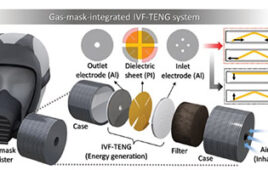
Minjeong Cha, MSE PhD Student, applies a gel made up of chiromagnetic nanoparticles that are a conduit for modulating light to a laser apparatus. Credit: Joseph Xu, Michigan Engineering
The high cost and requirement of extremely cold temperatures for operation are the two main hurdles preventing holograms and other related optical devices from becoming more widespread.
However, researchers from the University of Michigan and the Federal University of Sao Carlos in Brazil have found that inexpensive nanoparticles in a gel can be used at room temperature to control and modulate light in magnetic fields. This discovery brings us one step closer to utilizing holograms and other related optical devices in a number of applications, including autonomous vehicle sensors, communication in space and optical wireless networks.
Currently, the technologies used by magnetic fields to alter the path of light are expensive, brittle, opaque, and often only work in temperatures as cold as the vacuum of space.
Expensive rare-earth metals including europium, cerium and yttrium have been used in the past to demonstrate how the path, speed and intensity of optical or light-based signals can be controlled with magnetic fields.
This is already used in commercial applications with high-speed fiber optic internet cables, but it is too cost prohibitive and requires too cold of a temperature for the technology to become more widespread.
However, a cost effective, room temperature option to magnetically controlling twisted light could enable mass-market 3D displays, holographic projectors and new generations of Light Detection and Ranging (LIDAR).
“Many companies and labs developed exciting prototypes using magneto-optic technology,” said Nicholas Kotov, Michigan’s Florence V. Cejka Professor of Chemical Engineering, who led the project, said in a statement. “But their technological acceptance has been limited to date because of the fundamental materials issues with rare earth magneto-optics.
“It has been like trying to solve the Rubik’s Cube puzzle,” he added. “You get one property right but lose the others.”
In the study, the researchers showed that they could use nanoparticles based on inexpensive cobalt oxide—a white colored, magnetic semiconductor—to control twisted light while using magnetic fields. The team twisted the nanoparticles themselves by coating them with amino acids.
The nanoparticles could be twisted either right-or-left handed in a property called chirality, which produced a heightened sensitivity to magnetism and also strengthened interactions with twisted light—often called circularly polarized light.
The team demonstrated that by suspending the nanoparticles in a transparent, elastic, room-temperature gel, they could change the intensity of circularly polarized light by applying a magnetic field.
“This opens the road to the wide proliferation of magneto-optical devices with exciting possibilities emerging in 3D displays and real-time holography—all utilizing circularly-polarized light,” Kotov, who is also a professor of materials science and engineering, said. “Furthermore, the small size of the nanoparticles enables their use in computer engineering and large-scale manufacturing of magneto-optical composites.”




